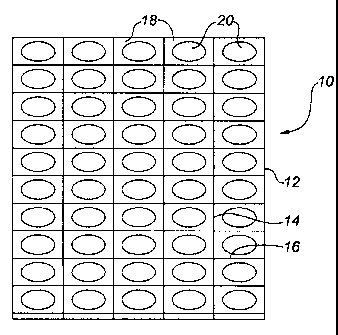Some of the information on this Web page has been provided by external sources. The Government of Canada is not responsible for the accuracy, reliability or currency of the information supplied by external sources. Users wishing to rely upon this information should consult directly with the source of the information. Content provided by external sources is not subject to official languages, privacy and accessibility requirements.
Any discrepancies in the text and image of the Claims and Abstract are due to differing posting times. Text of the Claims and Abstract are posted:
| (12) Patent: | (11) CA 2210941 |
|---|---|
| (54) English Title: | WOOD PRESERVATIVE WRAP |
| (54) French Title: | ENVELOPPE DE PRESERVATION DU BOIS |
| Status: | Term Expired - Post Grant Beyond Limit |
| (51) International Patent Classification (IPC): |
|
|---|---|
| (72) Inventors : |
|
| (73) Owners : |
|
| (71) Applicants : |
|
| (74) Agent: | NATHAN V. WOODRUFFWOODRUFF, NATHAN V. |
| (74) Associate agent: | |
| (45) Issued: | 2004-09-07 |
| (22) Filed Date: | 1997-07-21 |
| (41) Open to Public Inspection: | 1999-01-21 |
| Examination requested: | 2001-06-05 |
| Availability of licence: | N/A |
| Dedicated to the Public: | N/A |
| (25) Language of filing: | English |
| Patent Cooperation Treaty (PCT): | No |
|---|
| (30) Application Priority Data: | None |
|---|
A wood preservative wrap includes a body divided by liquid impervious grid lines into a plurality of pockets filled with wood preservative. The body is trimmable along the grid lines without compromising the containment of the wood preservative.
Une enveloppe de préservation du bois comprenant un corps divisé par les lignes d'une grille imperméable aux liquides en une pluralité de poches remplies d'un produit de préservation du bois. Le corps peut être rogné le long des lignes de la grille tout en permettant de retenir le produit de préservation du bois.
Note: Claims are shown in the official language in which they were submitted.
Note: Descriptions are shown in the official language in which they were submitted.

2024-08-01:As part of the Next Generation Patents (NGP) transition, the Canadian Patents Database (CPD) now contains a more detailed Event History, which replicates the Event Log of our new back-office solution.
Please note that "Inactive:" events refers to events no longer in use in our new back-office solution.
For a clearer understanding of the status of the application/patent presented on this page, the site Disclaimer , as well as the definitions for Patent , Event History , Maintenance Fee and Payment History should be consulted.
| Description | Date |
|---|---|
| Inactive: Office letter | 2017-11-01 |
| Letter Sent | 2017-11-01 |
| Letter Sent | 2017-11-01 |
| Letter Sent | 2017-11-01 |
| Letter Sent | 2017-11-01 |
| Inactive: Multiple transfers | 2017-10-24 |
| Inactive: Expired (new Act pat) | 2017-07-21 |
| Revocation of Agent Requirements Determined Compliant | 2011-05-30 |
| Inactive: Office letter | 2011-05-30 |
| Inactive: Office letter | 2011-05-30 |
| Appointment of Agent Requirements Determined Compliant | 2011-05-30 |
| Appointment of Agent Requirements Determined Compliant | 2007-12-27 |
| Inactive: Office letter | 2007-12-27 |
| Revocation of Agent Requirements Determined Compliant | 2007-12-27 |
| Inactive: Office letter | 2007-12-18 |
| Revocation of Agent Request | 2007-11-16 |
| Appointment of Agent Request | 2007-11-16 |
| Grant by Issuance | 2004-09-07 |
| Inactive: Cover page published | 2004-09-06 |
| Pre-grant | 2004-06-22 |
| Inactive: Final fee received | 2004-06-22 |
| Notice of Allowance is Issued | 2004-04-21 |
| Letter Sent | 2004-04-21 |
| Notice of Allowance is Issued | 2004-04-21 |
| Inactive: Approved for allowance (AFA) | 2004-04-13 |
| Amendment Received - Voluntary Amendment | 2004-03-18 |
| Inactive: S.30(2) Rules - Examiner requisition | 2003-09-18 |
| Letter Sent | 2001-06-27 |
| Request for Examination Requirements Determined Compliant | 2001-06-05 |
| All Requirements for Examination Determined Compliant | 2001-06-05 |
| Request for Examination Received | 2001-06-05 |
| Letter Sent | 2000-08-23 |
| Letter Sent | 2000-07-31 |
| Inactive: Entity size changed | 2000-07-31 |
| Reinstatement Requirements Deemed Compliant for All Abandonment Reasons | 2000-07-20 |
| Inactive: Single transfer | 2000-07-20 |
| Deemed Abandoned - Failure to Respond to Maintenance Fee Notice | 1999-07-21 |
| Letter Sent | 1999-06-21 |
| Letter Sent | 1999-06-21 |
| Inactive: Office letter | 1999-06-21 |
| Letter Sent | 1999-06-21 |
| Inactive: Single transfer | 1999-05-25 |
| Application Published (Open to Public Inspection) | 1999-01-21 |
| Inactive: First IPC assigned | 1997-10-15 |
| Classification Modified | 1997-10-15 |
| Inactive: IPC assigned | 1997-10-15 |
| Inactive: Filing certificate - No RFE (English) | 1997-09-29 |
| Filing Requirements Determined Compliant | 1997-09-29 |
| Application Received - Regular National | 1997-09-29 |
| Abandonment Date | Reason | Reinstatement Date |
|---|---|---|
| 1999-07-21 |
The last payment was received on 2004-04-21
Note : If the full payment has not been received on or before the date indicated, a further fee may be required which may be one of the following
Please refer to the CIPO Patent Fees web page to see all current fee amounts.
Note: Records showing the ownership history in alphabetical order.
| Current Owners on Record |
|---|
| 1824930 ALBERTA LTD |
| Past Owners on Record |
|---|
| CALVIN LEE MICHAEL WALL |
| WESLEY JAMES WALL |